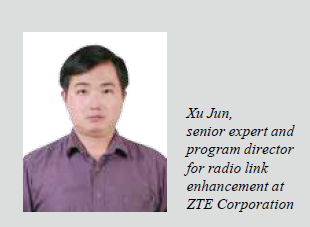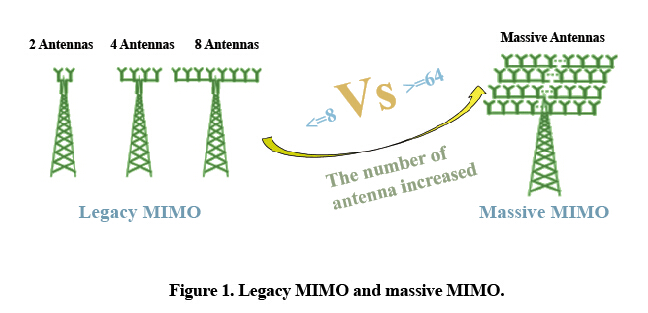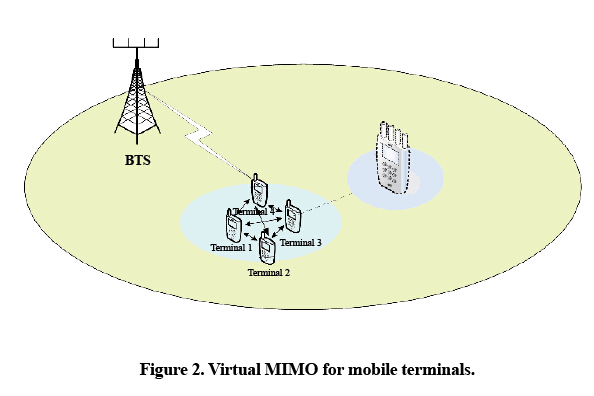Progress on 5G Radio Link Enhancement
 Future 5G networks will be primarily designed to improve system performance and support new services. 5G networks will:
Future 5G networks will be primarily designed to improve system performance and support new services. 5G networks will:
● increase capacity a thousand-fold
● increase single-user data rates ten-fold to a hundred-fold
● reduce service delay by one fifth
● increase the number of terminal connections a thousand-fold
● support new services, such as device-to-device (D2D), machine-type communication (MTC), vehicle-to-X (V2X), and ultra-reliable communication (URC).
Most of the key requirements of 5G are closely related to radio links. Enhancing radio link techniques is critical for 5G evolution.
Potential Techniques for Enhancing the 5G Radio Link
New radio link techniques involve massive MIMO, new multiple access, new coding modulation, enhanced HARQ, network coding, advanced receivers, and virtual MIMO.
Massive MIMO
Massive MIMO allows tens to thousands of arrays to be configured at the base station. This enables more precise beam control and higher spectral efficiency than legacy MIMO, where there are fewer than eight antenna arrays (Fig. 1). Massive MIMO also involves the use of spatial multiplexing and interference mitigation to increase system capacity; however, related channel information acquisition, antenna array design, codebook design, and reference signal design still need further research. Coordinated multi-point transmission (CoMP) is distributed massive MIMO, and centralized massive MIMO is an extension of CoMP.

New Multiple Access
In non-orthogonal multiple access (NOMA), information at the transmitter side is superposed in the power domain or code domain and is demodulated at the receiver side using SIC or ML demodulation. NOMA can be used in near-far scenarios to ensure maximum fairness between users and obtain the maximum sum rate. Currently, NOMA can be classified as power-domain or code-domain. To a certain extent, power-domain NOMA is an extension of the spatial, time or frequency domains and enables more users to access the system when resources for these domains are limited. Code-domain NOMA includes low-density CDMA and interleave division multiple access (IDMA). NOMA is mainly used in scenarios where there are too many users, or access cannot be easily synchronized. It can also be used when a base station has a relatively small number of antennas. Such a scenario arises in ultra-dense networks, large-scale and high-density user areas, D2D communication, M2M communication, and sensor networks.
Filter-bank multi-carrier (FBMC) is a frequency-division multiplexing technology that uses a group of filters to divide channel spectrum for frequency reuse. An FBMC system comprises synthetic filters at the transmitter side and analytic filters at the receiver side. FBMC outperforms OFDM in reducing out-of-band leakage and is particularly suitable for dynamic spectrum sharing. FBMC/OQAM increases system efficiency without cyclic prefix (CP) guard. FBMC does not require synchronization for uplink access channels.
New Coding Modulation
For high reliability, high throughput and low latency, much attention must be paid to technologies with multiple domain coding, grid coding modulation, low-bitrate short-to-medium length codes, new link-adaptive coding modulation based on error bitrate or error block rate estimation, gigabit ultrafast decoder, and physical-layer packet coding.
Enhanced Hybrid Automatic Repeat Request (HARQ)
To meet high-throughput and low-latency requirements, a 5G system needs to reduce HARQ retransmission, MAC-layer latency, and feedback overhead and increase retransmission. Enhanced feedback-based HARQ or packet-coding techniques can be used to reduce latency and HARQ retransmission; a new code bit selection and retransmission mechanism can be used to improve retransmission performance; and new feedback channel design schemes and iterative receivers can be used to reduce feedback overhead.
Network Coding
The basic concept of network coding is that network nodes are allowed to combine and retransmit information they have received. Relay nodes combine and encode information from different links. Network nodes function as both routers and coders. With a legacy data transmission policy, the source generates data; intermediate nodes copy, store and transmit the data; and the receiving node receives the data. The data is independent and irrelevant. However, network coding has overturned the idea that independent bits cannot be compressed. Now network information flows can be compressed to further improve spectral efficiency and network throughput.
Advanced Receivers
The computing power of mobile terminals will continue to grow rapidly in the next few decades, as dictated by Moore’s Law. IC receivers, iterative receivers, and maximum likelihood (ML) or maximum-a-posteriori (MAP) receivers can be used in a 5G system. Moreover, more advanced receivers, such as receivers with jointly optimized channel estimation, signal detection and decoding, can be applied in the 5G system. Receivers for special scenarios can also be used. Such receivers might be MMC receivers based on the compressed sensing mechanism or receivers for high mobility. In short, advanced receivers can improve spectral efficiency and system throughput.
Virtual MIMO
Because D2D communication is widely used in a 5G system, downlink virtual MIMO enbables multiple local users to share their receiving antennas and form a virtual single user MIMO (SU-MIMO) receiver or virtual diversity receiver (Fig. 2). This can greatly increase link capacity and reliability between the macrocell and terminals. A virtual SU-MIMO receiver improves performance compared to a legacy MU-MIMO receiver; therefore, communication in densely populated hotspots can be significantly improved. A virtual receive diversity receiver enables multiple users at the edge of the same cell to share their receiving antennas. This improves radio coverage at the cell edge, so virtual MIMO improves spectral efficiency and cell edge reliability.

ZTE’s Research on 5G Radio Link Enhancement
ZTE’s research on 5G radio link enhancement encompasses:
● massive MIMO. ZTE focuses on the design of high-dimensional codebook, reference signals and antenna arrays, and the relationship between massive MIMO and CoMP. ZTE has proposed two codebook models that address the issues of low precision and high overhead in legacy codebooks and has also proposed a compressed sensing-based reference signal design scheme to reduce pilot overhead. ZTE has also set up both link-level and system-level emulation platforms for all these technology domains and has completed several related research papers and patents.
● new coding modulation. ZTE has proposed soft decoding information-based error estimation for rapid link adaptation that can solve the problems of imprecise channel state information (CSI) feedback and a long outer loop link adaptation (OLLA) cycle. ZTE has also proposed multi-domain LDPC coding and new coding modulation schemes that boast lower complexity and better performance than other competing schemes in the industry. ZTE’s LDPC coding scheme can properly handle the wait time for inter-layer pipelining in existing hierarchical LDPC decoding. This doubles efficiency or speed without increasing hardware complexity. ZTE has devised a coding block-based packet coding scheme for enhanced system performance and rapid pipelining. Link-level emulation platforms have been set up for the above technology domains as well as for grid coding modulation (Lattice code) and short codes. A hardware platform has also been set up for ultrafast decoders. ZTE has completed several research papers and patents related to this area.
● enhanced HARQ. ZTE has proposed soft ACK/NACK-based and packet coding-based retransmission schemes to reduce HARQ retransmission and latency. ZTE has also defined a new redundant version to improve adaptive HARQ retransmission performance. Both link-level and system-level emulation platforms have been set up for all these technology domains, and even prototype verification platforms have been set up for other specific domains. ZTE has completed several related research papers and patents.
● network coding. ZTE’s focus of research includes network coding applications in uplink relay transmission, in a homogeneous network, in D2D communication, and in small cell scenarios. ZTE has set up link-level and system-level emulation platforms for all these technology domains and even prototype verification platforms for other specific domains. ZTE has accumulated the relative IPR.
● advanced receivers. ZTE has conducted research into the IRC receiver, SIC receiver, ML receiver, uplink MIMO multiaccess iterative receiver, single-antenna interference cancellation receiver, and jointly optimized receiver. Link-level emulation platforms have been set up for all these technology domains, and system-level emulation platforms have been set for the IRC receiver, SIC receiver, and ML receiver domain. ZTE has also completed several research papers and patents.
● new multiple access. ZTE has studied and evaluated NOMA in the power domain, low-density CDMA, and FBMC. ZTE has also proposed multi-user shared access (MUSA), which is developed based on code division to greatly increase the number of users that can simultaneously gain access. The newly designed code sequence has improved network capacity and prolonged terminal battery life. ZTE has set up link-level or system-level emulation platforms for all these technology domains, and has completed several related research papers and patents.
● virtual MIMO. ZTE has evaluated virtual MIMO technology through the system simulation research. The simulation result shows that virtual MIMO on the terminal side can significantly improve the link capacity between macro cells and terminals. ZTE has also proposed a new concept of coordinated relay cloud and suggested using virtual MIMO to increase backhaul link capacity between macro cells and the relay cloud. ZTE has completed several related research papers and patents.